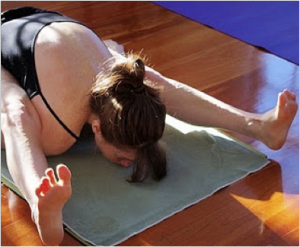This post is by Claudia Azula Altucher of Claudiayoga.com.
Back when I started practicing yoga I did not much care for studios or teachers. I thought I could be self-didactic and learn it all on my own. I was, after all an independent grown woman with a managing corporate job in New York City. How hard could yoga be?
And so I decided on a style I liked: Ashtanga. I mostly liked it because its “Mysore style” is practiced by the student alone, even if in a group setting.
This means that nobody needs to be in the studio at a specific time. No, instead one just goes, places the mat and starts practicing, then the instructor comes around and adjusts or adds or subtracts poses within the confines of a pre-determined series and depending on the student’s level. I liked the independence of that style; I was all about being on my own and doing things my way.
However, a time came in which some of the poses got to be a little uncomfortable. Take kurmasana, for example, the “turtle” pose. Much as I tried, there was no way I was going to get anywhere close to the final form of it and get all the healing benefits.Also by then, after about six months of going it alone I realized that maybe going to a studio and surrendering to a teacher may not be such a bad idea.
I was in awe on my first visit to a studio. Seeing others struggle or move faster and with much more grace was an inspiration and humiliation at the same time. I was in awe at the advanced students and could see my small progress in those that were just starting. Learning to keep the gazing point just into my practice was a big test.
By sticking to a teacher I learned of the benefits of having a regular human being who is much more advanced than me lead the way. I was able to relax, let the adjustments happen, and the deepening and openings be guided and supported. Not only that, I also learned about my teachers’ teacher, and his teacher in turn. I ended up very curious and traveling to India to the source and eventually tracing the chain to one short man 5’5’ in high: Tirumalai Krishnamacharya.
This man may not resonate as a household name unless you are in a yoga circle, but all of his students, or most of them would. For example, B.K.S. Iyengar, or Pattabhi Jois, Indra Devi, T.K.V. Desikachar—his son—or S.Ramaswami, amongh others, were all students of him. They all got a little piece of the wisdom of this master of yoga who is pretty much responsible for the basics of every yoga class you get on today, including that first one I finally dared take in mid-town New York City a few years ago.
In a world filled with so much yoga, how does one know to trust that this lineage or style? How is one to know that all the students that came from the tradition of Krishnamcharya are indeed good teachers? We do not know. There is no easy answer. All yoga teachers are people, and as with all people, you get all flavors.
There are a few stories of Krishnamacharya, however, that I always love re-reading. For example, in the 1950’s he was teaching yoga in a college in Chennai, but there was a difference of opinion with the management as of how he should be teaching.
Krishnamacharya, who by then was a master who had been studying and practicing the yoga sciences for over 35 years, was not willing to compromise on his teachings and the management threatened to dismiss him. To this he said: “Very well, I will have more time for my own practice.”
Another time Krishanamacharya was conducting a “rare” demonstration-class (he normally taught only one-on-one) where he mentioned that there are thirty-two variations of headstands. The class was silent. A student of him, A.G.Mohan, doubted him but did not say anything; however, the muscles in his face betrayed him and showed his feelings. Krishnamacharya looked at him and said: “What? It looks like you don’t believe me. Fold that mat and place it here”. He then demonstrated the 32 variations of headstand. He was 85 year -old.
These stories come from a book written by that dubious student, A.G. Mohan. Perhaps the most interesting one happens about a week before the time in which the great yogi died. This same student asked him the question: “What is important in life?” to which he replied, “Money is not important. Health, Longevity. A tranquil mind.”
Through these stories I see a dedicated, truth seeking, fierce, and determined practitioner who cares deeply about having a tranquil mind. And maybe these are the best guidelines we can follow when we are looking for a teacher to trust, a style that resonates, a yoga studio where we can surrender and gain all the benefits of yoga.
Finding out that a man of this stature was behind those poses I was doing every day, and that there was a method to the madness made me stop and reconsider, get more focused, trust the system. It gave me faith that through dedication it is possible to attain all that yoga has to offer not just “on”, but also “off” the mat.
I find it important to have as inspiration someone who walked the talk—someone who knew, through years of experience—what the science of yoga was, and could relate it to others.
I wish I had met him, but I never did.
They say that to get good at things, one needs to be mentored. I believe that for any endeavor one might try in life, it’s important to seek the best in the field, then imitate, fake it till one makes it, and keep the faith—not just in yoga, but in any field. Don’t you?
Claudia Azula Altucher has studied yoga for over a decade and all over the world including the Ashtanga Yoga Research Institute in Mysore, India, and at Centered Yoga in Thailand. She writes daily at Claudiayoga.com.












Recent Comments